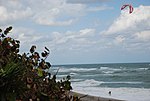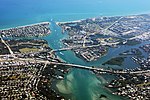Blowing Rocks Preserve

Blowing Rocks Preserve is an environmental preserve on Jupiter Island in Hobe Sound, Martin County, Florida, USA. It is owned by The Nature Conservancy. It contains the largest Anastasia limestone outcropping on the state's east coast. Breaking waves spray plumes of water through erosion holes; the spray can reach heights of 50 feet (15 m). This distinctive spectacle thus earned the limestone outcrop's name. The limestone outcropping also encompasses coquina shells, crustaceans, and sand. The preserve also features several coastal ecotones, including maritime hammocks, mangrove wetlands, and beach dunes. Common native species include sea grapes, gumbo limbo, and Sabal palms. Invasive exotic plants are removed in order to preserve indigenous flora. The preserve includes an educational center, native plant nursery, boardwalk, oceanside path, and a butterfly garden. The Hawley Education Center features rotating natural history and art exhibits, and offers environmental education classes and workshops. A boardwalk along the Indian River Lagoon contains interpretive signs about the plants, wildlife and area environment.
Excerpt from the Wikipedia article Blowing Rocks Preserve (License: CC BY-SA 3.0, Authors, Images).Blowing Rocks Preserve
South Beach Road,
Geographical coordinates (GPS) Address Nearby Places Show on map
Geographical coordinates (GPS)
| Latitude | Longitude |
|---|---|
| N 26.9745 ° | E -80.081 ° |
Address
The Nature Conservancy Blowing Rocks Preserve
South Beach Road 574
33455
Florida, United States
Open on Google Maps








